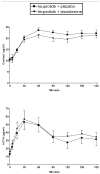Testosterone suppression of CRH-stimulated cortisol in men
- PMID: 15841103
- PMCID: PMC1470424
- DOI: 10.1038/sj.npp.1300742
Testosterone suppression of CRH-stimulated cortisol in men
Abstract
Despite observations of age-dependent sexual dimorphisms in hypothalamic-pituitary-adrenal (HPA) axis activity, the role of androgens in the regulation of HPA axis activity in men has not been examined. We assessed this role by performing CRH stimulation tests in 10 men (ages 18-45 years) during gonadal suppression with leuprolide acetate and during testosterone addition to leuprolide. CRH-stimulated cortisol levels as well as peak cortisol and greatest cortisol excursion were significantly lower (p<0.05, 0.005, and 0.01, respectively) during testosterone replacement compared with the induced hypogonadal condition (leuprolide plus placebo); cortisol area under the curve was lower at a trend level (p<0.1). Paradoxically, CRH-stimulated corticotropin (ACTH) was increased significantly during testosterone replacement (p<0.05). The cortisol : ACTH ratio, a measure of adrenal sensitivity, was lower during testosterone replacement (p<0.1). A mixed effects regression model showed that testosterone but not estradiol or CBG significantly contributed to the variance of cortisol. These data demonstrate that testosterone regulates CRH-stimulated HPA axis activity in men, with the divergent effects on ACTH and cortisol suggesting a peripheral (adrenal) locus for the suppressive effects on cortisol. Our results further demonstrate that the enhanced stimulated HPA axis activity previously described in young men compared with young women cannot be ascribed to an activational upregulation of the axis by testosterone.
Figures


Similar articles
-
Sex-related differences in stimulated hypothalamic-pituitary-adrenal axis during induced gonadal suppression.J Clin Endocrinol Metab. 2005 Jul;90(7):4224-31. doi: 10.1210/jc.2004-2525. Epub 2005 May 10. J Clin Endocrinol Metab. 2005. PMID: 15886244
-
ACTH and cortisol response to Dex/CRH testing in women with and without premenstrual dysphoria during GnRH agonist-induced hypogonadism and ovarian steroid replacement.J Clin Endocrinol Metab. 2012 Jun;97(6):1887-96. doi: 10.1210/jc.2011-3451. Epub 2012 Mar 30. J Clin Endocrinol Metab. 2012. PMID: 22466349 Free PMC article. Clinical Trial.
-
Sex difference in the relationship between the hypothalamic-pituitary-adrenal axis and sex hormones in obesity.Obesity (Silver Spring). 2006 Feb;14(2):235-43. doi: 10.1038/oby.2006.30. Obesity (Silver Spring). 2006. PMID: 16571848
-
Assessment of stimulated and spontaneous adrenocorticotropin secretory dynamics identifies distinct components of cortisol feedback inhibition in healthy humans.J Clin Endocrinol Metab. 1996 Nov;81(11):3883-91. doi: 10.1210/jcem.81.11.8923833. J Clin Endocrinol Metab. 1996. PMID: 8923833 Clinical Trial.
-
The stress system in the human brain in depression and neurodegeneration.Ageing Res Rev. 2005 May;4(2):141-94. doi: 10.1016/j.arr.2005.03.003. Ageing Res Rev. 2005. PMID: 15996533 Review.
Cited by
-
Endogenous testosterone levels are associated with amygdala and ventromedial prefrontal cortex responses to anger faces in men but not women.Biol Psychol. 2009 May;81(2):118-22. doi: 10.1016/j.biopsycho.2009.03.004. Epub 2009 Mar 25. Biol Psychol. 2009. PMID: 19428976 Free PMC article.
-
Association between Brain Injury Markers and Testosterone in Critically-Ill COVID-19 Male Patients.Microorganisms. 2022 Oct 22;10(11):2095. doi: 10.3390/microorganisms10112095. Microorganisms. 2022. PMID: 36363686 Free PMC article.
-
Developmental patterns of hair cortisol in male and female nonhuman primates: lower hair cortisol levels in vervet males emerge at puberty.Psychoneuroendocrinology. 2012 Oct;37(10):1736-9. doi: 10.1016/j.psyneuen.2012.03.015. Epub 2012 Apr 10. Psychoneuroendocrinology. 2012. PMID: 22497987 Free PMC article.
-
GWAS of allometric body-shape indices in UK Biobank identifies loci suggesting associations with morphogenesis, organogenesis, adrenal cell renewal and cancer.Sci Rep. 2021 May 21;11(1):10688. doi: 10.1038/s41598-021-89176-6. Sci Rep. 2021. PMID: 34021172 Free PMC article.
-
A Clinical Perspective of Sleep and Andrological Health: Assessment, Treatment Considerations, and Future Research.J Clin Endocrinol Metab. 2019 Oct 1;104(10):4398-4417. doi: 10.1210/jc.2019-00683. J Clin Endocrinol Metab. 2019. PMID: 31042277 Free PMC article. Review.
References
-
- Bingaman EW, Magnuson DJ, Gray TS, Handa RJ. Androgen inhibits the increases in hypothalamic corticotropin-releasing hormone (CRH) and CRH-immunoreactivity following gonadectomy. Neuroendocrinology. 1994;59:223–234. - PubMed
-
- Brett LP, Chong GS, Coyle S, Levine S. The pituitary-adrenal response to novel stimulation and ether stress in young adult and aged rats. Neurobiol Aging. 1983;4:133–138. - PubMed
-
- Burgess LH, Handa RJ. Chronic estrogen-induced alterations in adrenocorticotropin and corticosterone secretion, and glucocorticoid receptor-mediated functions in female rats. Endocrinology. 1992;131:1261–1269. - PubMed
-
- Carey MP, Deterd CH, de Koning J, Helmerhorst F, De Kloet ER. The influence of ovarian steroids on hypothalamic-pituitary-adrenal regulation in the female rat. J Endocrinol. 1995;144:311–321. - PubMed
-
- Collins A, Frankenhaeuser M. Stress responses in male and female engineering students. Journal of Human Stress. 1978;4:43–48. - PubMed
Publication types
MeSH terms
Substances
Grants and funding
LinkOut - more resources
Full Text Sources
Research Materials
Miscellaneous

